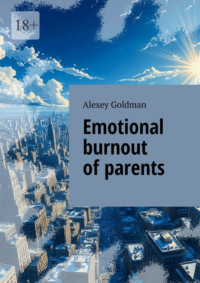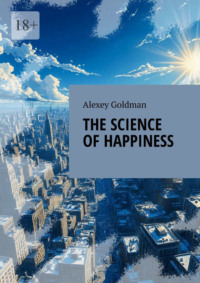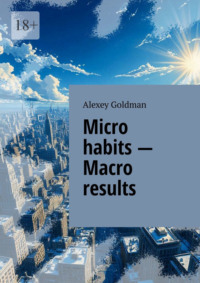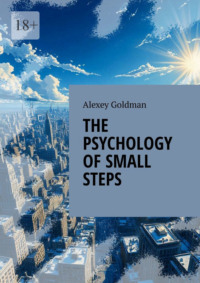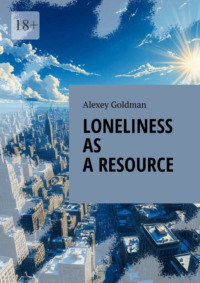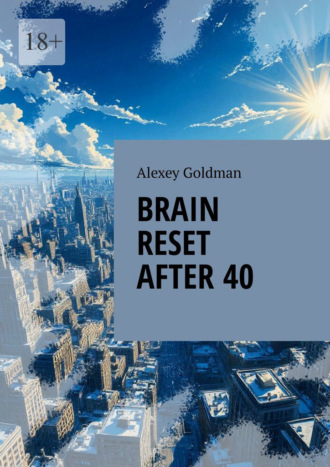
Полная версия
Brain reset after 40

Brain reset after 40
Alexey Goldman
© Alexey Goldman, 2025
ISBN 978-5-0068-0014-4
Created with Ridero smart publishing system
Alexey Goldman
Brain reset after 40
Chapter 1: Your Brain After 40: Not Decline, But New Possibilities!
“Welcome to the start of an amazing journey! If you’re over 40 and sometimes catch yourself thinking ‘oh, my memory isn’t what it used to be’ or ‘I just don’t have the energy,’ this book is your trusted guide. Let’s bust the biggest myth right now!”
Busting the Big Myth: “The brain ages and declines – and there’s nothing you can do about it.” Not true! That’s an outdated notion. Think of your brain not as a static rock, but more like playdough or a muscle. Yes, it changes, but it remains incredibly flexible and capable of learning at ANY age! This is called neuroplasticity (in simple terms: the brain’s ability to change, create new connections, and learn). After 40, this isn’t just possible – it’s the key to mental clarity and energy!
Why We Notice Changes: Life after 40 is often more intense and complex (work, family, responsibilities). The brain gets overloaded, and old “autopilot” routines can start to glitch (“Where are my keys?” “What’s the new colleague’s name?”). This isn’t decline; it’s a signal: it’s time to give your brain new challenges!
Science is On Our Side: Research shows that the adult brain is perfectly capable of creating new neurons (brain cells) and connections between them, especially if we train it. A famous example: studies of London taxi drivers showed their hippocampi (the memory center) actually grew as they learned the city’s map!
Your Strengths RIGHT NOW: After 40, your brain possesses unique advantages:
Wisdom and Experience: You can see the bigger picture, find creative solutions, and understand people better.
Emotional Resilience: You often handle stress better than you did in your youth.
Crystallized Intelligence: The knowledge and skills accumulated over the years are your powerful resource!
Practical Exercise: “My Strengths”
Take a piece of paper.
Write down 3—5 things you are good at right now (it can be anything: cooking, resolving conflicts, planning trips, understanding technology, listening to others).
Write how each of these strengths helps you in life.
Goal: To realize that your brain is already a powerful tool that can be made even better!
Motivational Example: Olga, 52. She always dreamed of painting but was afraid it was “too late” to start. At 48, she signed up for a beginner’s course. It was tough at first, but she practiced a little every day. Now her paintings are exhibited in the local library! “I feel like my brain has come alive; I have incredible energy and joy from creating. Now I know – it’s never too late to learn!”
Your brain after 40 isn’t a weakening flashlight; it’s a powerful spotlight that just needs the right tuning and new tasks. Neuroplasticity is your super-skill! Ready to unlock it? Let’s go!
Chapter 2: The Foundation of Reset: Sleep – Your Main Ally
“Imagine a nightly cleaning and repair crew working inside your head. Sleep isn’t a luxury; it’s a vital construction site for your brain!”
Why Sleep is More Important Than Ever After 40:
Brainwash: During deep sleep, the glymphatic system activates (simply put: the brain’s “cleaning” system). It flushes out toxins and “debris” (including proteins linked to cognitive decline) that accumulate during the day. Without good sleep, this debris builds up – leading to “brain fog,” fatigue, and memory issues.
Memory Consolidation: Sleep is when the brain “files away” new information, transferring it from short-term to long-term memory. Poor sleep means poor recall.
Energy Refueling: Quality sleep restores energy reserves in brain cells. Miss sleep, and your battery is dead by lunchtime.
Emotional Balance: Lack of sleep makes us irritable, anxious, and less resilient to stress.
How Sleep Changes After 40 (This is Normal):
Harder to fall asleep.
Wake up more often during the night (especially near morning).
Less deep sleep.
Sleep schedule is easier to disrupt.
Important: Don’t write off chronic insomnia just to age! It can and should be addressed.
Practice: Sleep Hygiene – Your Ritual for Great Rest. It’s not complicated but requires consistency:
Consistency is King: Go to bed and wake up at the same time every day (even on weekends!). This sets your internal clock.
Bedtime Ritual (30—60 min): A signal to your brain that it’s “time to wind down.” Try a warm bath/shower, calm music, reading (not from a screen!), light stretching, meditation, a cup of herbal tea (chamomile, lemon balm). Avoid: Bright lights, heavy meals, alcohol, caffeine, heated discussions, work.
Bedroom = Sleep Sanctuary: Keep it cool (18—21°C / 64—70°F), QUIET (earplugs are great!), and COMPLETELY DARK (sleep mask, blackout curtains). Remove the TV, laptop, and smartphone!
Bed is Only for Sleep and Intimacy: Don’t work, watch TV, or scroll through your phone in bed.
Morning Daylight: Open the curtains or step onto the balcony – light helps set your biological rhythms.
What to Do If You Can’t Sleep? (Simple Strategies):
The 20-Minute Rule: Can’t fall asleep after 20 minutes? Get up, go to another room, and do something calm and boring in dim light (like read a physical book). Return to bed only when you feel sleepy.
Don’t Watch the Clock! This increases anxiety (“Oh no, it’s already 3 AM, and I’m not asleep!”).
4-7-8 Breathing: Inhale through your nose for 4 counts, hold for 7 counts, exhale through your mouth (with a slight whoosh sound) for 8 counts. Repeat 4—5 times. This calms the nervous system.
Example: Sergei, 47. He constantly felt worn out and had “mush for brains” by afternoon. He started going to bed at 11:00 PM (putting aside all work/devices), bought blackout curtains and earplugs. He created a ritual: 15 minutes of reading a physical book + a cup of chamomile tea. “Within two weeks, I started waking up naturally at 6:30, without an alarm! I have energy all day, and my head is clear. Now I understand that sleep isn’t a waste of time but an investment in myself!”
Quality sleep isn’t a privilege; it’s a basic need for your brain’s reset. Start small – choose 1—2 items from the sleep hygiene list and implement them this week. Your brain will thank you!
Chapter 3: “Fuel” for a Sharp Mind: Nourishing Your Brain the Right Way
“Imagine your brain is a high-performance sports car. What kind of fuel are you going to put in the tank? Cheap, low-grade gasoline or high-quality premium fuel? Your choice determines how far and how fast you’ll go!”
Your brain is an energy-intensive organ: even though it only weighs about 2% of your body mass, it consumes roughly 20% of your energy and oxygen! It needs the right kind of “fuel.”
What the Brain Loves (Its Best “Friends”):
Fatty Fish (salmon, mackerel, herring, sardines): A prime source of Omega-3 fatty acids (especially DHA). This is the building material for brain cells, it improves communication between neurons, and protects against inflammation. Aim for at least two servings a week!
Berries (blueberries, strawberries, blackberries): Packed with antioxidants (anthocyanins) that fight cellular damage in the brain (the “rust” caused by stress and aging) and improve memory.
Nuts and Seeds (walnuts, almonds, flax seeds, chia seeds): A great source of Omega-3s (especially walnuts), Vitamin E (a powerful antioxidant), healthy fats, and protein. A handful of nuts makes for a perfect snack!
Leafy Greens (spinach, kale, arugula, lettuce): Rich in vitamins K, lutein, and folate – all of which improve cognitive function and slow brain aging.
Water!: Even mild dehydration (which we often don’t even notice) impairs concentration, memory, and can cause fatigue and headaches. Drink regularly throughout the day! (1.5—2 liters is a good guide, but listen to your thirst).
Eggs: A source of choline – a precursor to the crucial neurotransmitter acetylcholine, which is responsible for memory and mood.
Dark Chocolate (70% cocoa or higher): The flavonoids improve blood flow to the brain and even stimulate the growth of new neurons. A square or two is a perfect brainy treat!
What Harms the Brain (Its “Foes”):
Excess Sugar and Refined Carbs (white bread, pastries, sweets, soda): Cause blood sugar spikes → leading to “brain fog,” fatigue, inflammation, and damage to blood vessels. For those with a sweet tooth: try replacing these with fruits/berries or dark chocolate.
Trans Fats and Excess Saturated Fats (fast food, fried food, margarine, fatty red meat): Impair blood vessel function and increase the risk of inflammation in the brain.
Excess Alcohol: Toxic to neurons, disrupts sleep, and causes dehydration. Moderation is key.
Practice: Simple Steps Towards “Smart” Eating
The “Plate Rule”: Fill ½ of your plate with vegetables/greens, ¼ with quality protein (fish, poultry, legumes, eggs), and ¼ with complex carbohydrates (whole grains: buckwheat, quinoa, brown rice, oatmeal).
“Brain-Boosting” Snacks (Ready-Made Ideas):
A handful of nuts + an apple or a handful of berries.
Carrot sticks/cucumber + hummus.
A hard-boiled egg.
Natural yogurt + a spoonful of flax/chia seeds + berries.
A slice of whole-grain bread + avocado or a slice of salmon.
Easy Hydration Habits:
A glass of water first thing in the morning on an empty stomach.
A glass of water before each meal.
Keep a stylish water bottle visible on your desk or in your bag.
Have a glass of water instead of evening tea (if it doesn’t disrupt your sleep).
Focus on a Mediterranean Style Diet: Loads of vegetables/fruits, fish, olive oil, nuts, whole grains, moderate amounts of poultry/eggs/dairy, and minimal red meat and sweets.
Example: Marina, 55. She often snacked on cookies and candy at work, drank little water, and felt drowsy after lunch. She started bringing a container of chopped veggies and hummus, apples, and nuts to work. She bought a nice one-liter water bottle and makes sure to drink two of them during the workday. “Within a week, the heavy feeling after meals was gone, as was the afternoon slump. I have more energy now. And I’ve even lost a couple of kilos!”
You can’t control everything, but you absolutely control what you put on your plate. You don’t need complicated diets. Start by adding more of the brain’s “friends” (fish, berries, nuts, water) and gradually push out its “foes” (sugar, harmful fats). Every healthy choice is an investment in your mental clarity and energy reserves!
Chapter 4: Movement = Thinking: How Physical Activity Charges Your Brain
“Exercise isn’t just for your waistline! It’s the most powerful ‘fertilizer’ for your brain. Don’t believe me? Let’s break it down!”
Why Movement is the Brain’s Best Friend After 40:
An Oxygen Cocktail: Physical activity boosts blood flow throughout your entire body, including your brain. More blood → more oxygen and nutrients → your neurons work better!
Growth of New Cells and Connections: Exercise stimulates the production of BDNF (Brain-Derived Neurotrophic Factor) – think of it as a “super-vitamin” for your brain! It helps grow new neurons (neurogenesis) and strengthens the connections between them (synapses), especially in the hippocampus (the memory and learning center).
Protection from “Rust”: It reduces inflammation and oxidative stress, which damage brain cells as we age.
Energy and Mood: Regular activity boosts energy levels, reduces fatigue, fights stress and anxiety, and improves sleep – all of which directly impact mental clarity.
Memory and Attention: Research shows that even moderate, but regular, exercise improves memory, processing speed, and the ability to concentrate.
What Kind of Activity is Best? Anything you enjoy! The key is consistency.
Walking – The Superhero: Accessible to everyone! Nordic walking is particularly beneficial – it engages up to 90% of your muscles and is easy on the joints. Start with 20—30 minutes a day at a comfortable pace.
Dancing: A great cardio workout + coordination + memory (remembering steps) + social interaction + pure joy!
Swimming/Water Aerobics: Gentle on the joints, works the whole body, and is very relaxing.
Yoga/Tai Chi/Pilates: Improve flexibility, strength, balance, and coordination; reduce stress; and teach mindfulness and proper breathing.
Конец ознакомительного фрагмента.
Текст предоставлен ООО «Литрес».
Прочитайте эту книгу целиком, купив полную легальную версию на Литрес.
Безопасно оплатить книгу можно банковской картой Visa, MasterCard, Maestro, со счета мобильного телефона, с платежного терминала, в салоне МТС или Связной, через PayPal, WebMoney, Яндекс.Деньги, QIWI Кошелек, бонусными картами или другим удобным Вам способом.





